Cabin fever is beginning to set in. Three weeks post-op and I’m beginning to find that the four walls are closing in. There are only so many box sets that you can watch and only so much paperwork you can tolerate in one sitting.
Hopefully after the Christmas festivities I will be able to do a little more than observe the activities on the farm.
As the year draws to a close, it is time to reflect on the year just gone and plan for the year to come. Overall, the weather was on our side this year. We had a decent amount of sunshine and rain to keep the grass growing and plenty of opportunity to save winter fodder in the form of silage and hay. Our stock did well over the year as a result of the settled weather conditions and an abundance of grass available.
The question now is whether this will be repeated next year or not. As always, we will be checking for up-to-date forecasts at critical times of the year.
As another year of grass recording has drawn to a close, it is interesting to make comparisons between fields, this year and last.
Though I am monitoring it more closely, the results were not always an improvement on previous years. But information is key to driving on further farm development.
In total, the farm grew 12t DM/ha (dry matter per hectare) this year, which is up from 11.45t DM/ha last year. This was done with less fertilizer and better grassland management. My fields produced from a high of 20t DM/ha to a low of 3.5t DM/ha.
The fields that have under-performed will be soil-tested and any imbalances will be rectified before reseeding next year. The top-producing field presented a different challenge in terms of maintaining the sward quality, but these are problems I would rather have.
On the back of excellent grass growing conditions this year, the lambs have performed exceptionally well. There was an increase in the average carcase weight sold this year, leaving us with a higher price per lamb and a little extra profit made to help cover last year’s expensive cost of production.
The housing process started here last week with the first 250 ewes housed. These will be dosed for fluke next week.
I recently received results back from dung samples I had sent off for testing for the presence of fluke eggs. The results showed that there were no liver fluke eggs present, but that there were rumen fluke eggs present.
I know that a number of years ago there was a massive problem with rumen fluke in stock around the country.
However, it is likely that small numbers of these parasites cause little or no damage to stock. Fortunately for me, the product I have chosen to dose my ewes with for liver fluke is also effective against rumen fluke and I will kill two birds with one stone.
As the children’s excitement builds here in the run-up to Christmas, I would like to take the opportunity to wish everyone a very happy Christmas and a prosperous New Year.





SHARING OPTIONS